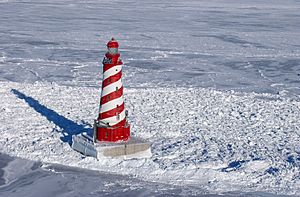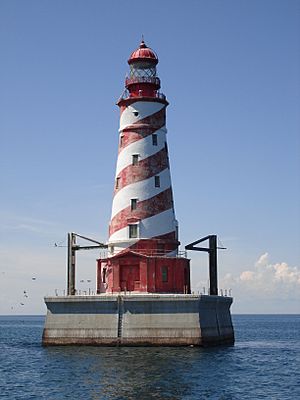White Shoal Light, Michigan facts for kids
 |
|
|
|
|
| Location | Lake Michigan west of the Straits of Mackinac, Emmet County, Michigan |
|---|---|
| Coordinates | 45°50′32″N 85°8′7″W / 45.84222°N 85.13528°W |
| Year first lit | 1910 |
| Automated | 1976 |
| Foundation | cofferdam/timber exposed Crib pier/concrete pier. |
| Construction | Terra Cotta//steel/brick interior; gunnite exterior; aluminium lantern |
| Tower shape | Octagonal base on building; frustum of a cone. |
| Markings / pattern | White orig./Red and White barber pole tower, red lantern & base |
| Height | 121 feet (37 m) |
| Focal height | 125 feet (38 m) |
| Original lens | 2nd order bivalve Fresnel Lens |
| Current lens | 7.5-inch (190 mm) Tideland Signal acrylic lens |
| Intensity | 1.2 million candle power |
| Range | 17 nautical miles (31 km; 20 mi) |
| Characteristic | flashing 5 sec |
| Fog signal | Diaphone originally, HORN 1 blast every 30", 3" blast. Operates year round. |
| Racon | "K" (– • –). |
| ARLHS number | USA-886 |
| USCG number | 7-17750 |
The White Shoal Light is a famous lighthouse in Lake Michigan. It is about 20 miles west of the Mackinac Bridge. This lighthouse helps ships find their way safely. It is also the tallest lighthouse on the Great Lakes.
Contents
History of the Lighthouse
Why Lighthouses Were Built
From the mid-1800s to the early 1900s, many lighthouses were built on the Great Lakes. This was done by the United States Lighthouse Board. They built lots of new lights to guide ships.
At first, lighthouses were often small towers on top of a keeper's house. Later, taller brick towers were built to make the light shine further. By the 1890s, steel towers started to replace the older brick ones.
The White Shoal Light was a big step forward. Engineers wanted to build lights on dangerous shoals (shallow areas) and reefs far from land. Before this, Light ships were used. But lightships were risky for sailors and hard to keep in place during storms. They could drift, making them unreliable for ships.
So, engineers learned to build strong lighthouses right on the water. Famous ones like Spectacle Reef Light and Stannard Rock Light were built this way. The White Shoal Light, finished in 1910, was one of the last and most impressive of these projects.
Building the White Shoal Light
Work on the White Shoal Light began in 1908. It was finished and started guiding ships on September 1, 1910. The project cost about $225,000.
This lighthouse was important because more and more cargo ships were using the Straits of Mackinac. The White Shoal Light helped protect these ships and their crews. Before it was built, a lightship called LV56 marked the White Shoal.
The main part of the lighthouse, called the crib pier, was built in St. Ignace, Michigan. Then it was floated out to the shoal by ship. The lighthouse also had a fog signal to warn ships in bad weather. It even had an underwater bell that would ring a special code. This was an early way to warn ships before modern radar systems like RACON were invented.
What Makes It Special
The White Shoal Light is very unique for several reasons:
- Giant Lens: It used to have a huge Fresnel lens (a special type of lighthouse lens) made in Paris. This lens was so powerful it could be seen up to 28 miles away! It floated on a bed of mercury and was turned by a clockwork system. In 1976, the lighthouse became automated, meaning it no longer needed keepers. The original lens is now at the Whitefish Point Light Museum.
- Aluminum Top: It's the only lighthouse on the Great Lakes with an aluminum top. Most others have tops made of cast iron.
- Candy Cane Stripes: Its most famous feature is its red and white diagonal stripes. People often call it the 'candy cane' lighthouse or 'barber pole' lighthouse. It's the only one in the United States with this exact design.
- Michigan Icon: Because of its unique look, the State of Michigan uses it as a symbol. It's featured on the "Save Our Lights" license plate. Money from these license plates helps pay to protect and restore lighthouses in Michigan. Michigan has more lighthouses than any other state!
Many people love to photograph and draw the White Shoal Light because of its special shape and colors.
Visiting the Lighthouse
If you want to see the White Shoal Light up close, you have a few options.
The White Shoal Light Historical Preservation Society now owns and takes care of the lighthouse. They offer boat tours, including longer trips with meals and even overnight stays! These tours help support the lighthouse's preservation.
You can also see the light from a private boat. Or, you can take a lighthouse cruise with Shepler's Ferry Service from Mackinaw City. Their tours often pass by the White Shoal Light and other nearby lighthouses like Waugoshance Light.
Another exciting way to see it is by chartering a seaplane for a tour of the area.
In 2016, the White Shoal Light was sold at auction. The White Shoal Light Historical Preservation Society bought it to make sure it would be preserved for the future.



